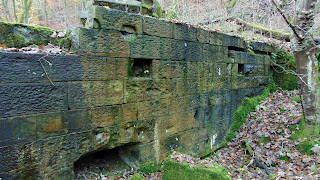Located between Rochdale and Heywood and situated at the bottom of a densely wooded valley, and close to the banks of the river Roch. The area originally known as ‘Natfield’ has been mentioned in documents that go back to 1534.In the early stages of the Industrial Revolution, the banks of the river Roch, was the most sought after location for the emerging manufacturers of wool and cotton processing, as they could use the potent source of the river to power the machinery.
Legends
If you take the footpath heading east towards Meadow Mill,
was a row of cottages
which have since disappeared. The cottages were situated on
a spot known as
‘Tyrone’s Bed’, or the dialectical corruption ‘Yel’s of
Throne’.
Embellished in John
Roby’s Traditions of Lancashire (2 vols, Manchester, 1872), I, 220–46:
according to legend, the Earl of Tyrone hid in these woods close to Gnat Bank.
In a bend of the Roach, to the north of
Morland or Merland, is Tyrone’s Bed, a woody glen, admired for its picturesque
scenery, which is said to have been the retreat of one of the Earls of Tyrone
in the reign of Elizabeth. The craggy rocks on the one side of this lovely
valley, and the steep wooded slopes on the other, with the rivulet in the
channel below, are not inappropriately termed “the bed;” but the chief interest
of this “romantic dell” centred in the ancient home of the Holts of
Grizelhurst, but of which not a vestige now remains. At the period of the
legend it was surrounded “by dark and almost trackless woods,” which would
furnish a refuge for the wanderer, “secure from hostility or alarm.” The Earl
of Tyrone who claimed to be a King in Ireland, by his rebellions harassed Queen
Elizabeth and her armies for years during the latter period of her reign. His
history would fill a volume. Hugh O’Neale was nephew to Shan (John) O’Neale, or
“the great O’Neale,” as he was more commonly called. He was well known for his
great courage, a virtue much prized by the half-civilised hordes he commanded.
He was created Earl of Tyrone by Queen Elizabeth, but disliking the allegiance
this implied, and desirous to liberate his country from the English yoke, he
entered into a correspondence with Spain, procured from thence a supply of arms
and ammunition; and having united many of the Irish chiefs in a dependence upon
himself, he soon proved himself a formidable enemy of English rule in Ireland.
Tyrone and the other chiefs fled, and the Spaniards capitulated. It is supposed
that at this period the outlawed Earl crossed the sea into England, and
remained for some time concealed in the neighbourhood of Rochdale. The site of
a few cottages in a romantic dell by the river Roach is still associated with
the memory of the unfortunate Earl, and yet bears the name of “Tyrone’s Bed.”
Upon this fact Mr Roby has based a fictitious love story. Tyrone is made to save from drowning
Constance the daughter of Holt of Grizelhurst; they love; she conceals him from
pursuit by the sheriff and posse in a hidden chamber, the entrance to which is
from her own bedroom. He escapes, and she wastes away and dies, the victim of
the prophecy. Tyrone eventually secured a pardon from Queen Elizabeth.
source: http://moorwood.de/index.
Complete video footage by Martin Zero: What lies under the old mill ?









































No comments:
Post a Comment